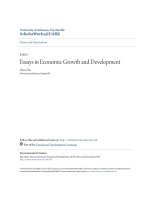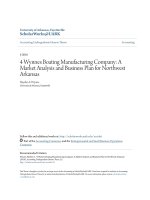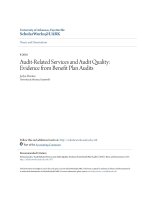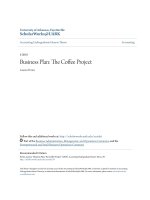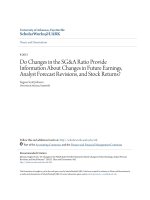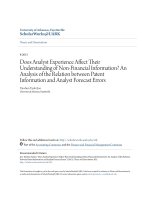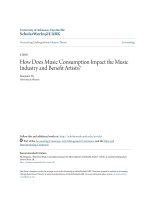Accounting undergraduate Honors theses: New business initiatives and financial performance
Bạn đang xem bản rút gọn của tài liệu. Xem và tải ngay bản đầy đủ của tài liệu tại đây (9.82 MB, 232 trang )
University of Arkansas, Fayetteville
ScholarWorks@UARK
Theses and Dissertations
5-1999
New Business Initiatives and Financial
Performance
Douglass Cagwin
University of Arkansas, Fayetteville
Follow this and additional works at: />Part of the Accounting Commons, and the Business Administration, Management, and
Operations Commons
Recommended Citation
Cagwin, Douglass, "New Business Initiatives and Financial Performance" (1999). Theses and Dissertations. 2998.
/>
This Dissertation is brought to you for free and open access by ScholarWorks@UARK. It has been accepted for inclusion in Theses and Dissertations by
an authorized administrator of ScholarWorks@UARK. For more information, please contact ,
NEW BUSINESS INITIATIVES AND
FINANCIAL PERFORMANCE
Reproduced with permission of the copyright owner. Further reproduction prohibited without permission.
NEW BUSINESS INITIATIVES AND
FINANCIAL PERFORMANCE
A dissertation submitted in partial fulfillment
of the requirements for the degree o f
Doctor o f Philosophy
By
DOUGLASS CAGWIN, B.B.A, M.Acc.
Iowa State University, 1993
University o f Arkansas, 1996
May 1999
University o f Arkansas
Reproduced with permission of the copyright owner. Further reproduction prohibited without permission.
Table of Contents
Page
Number
C H A PT E R 1: INTRODUCTION
INTRODUCTION............................................................................. V . ...........
1
BACKGROUND AND M O TIV ATIO N.......................................................
2
RESEARCH QUESTIONS.............................................................................
4
THE ST U D IES.................................................................................................
5
SU M M A R Y .......................................................................................................
7
C H A PT E R 2: TH E ASSOCIATION BETW EEN USE O F NEW BUSINESS
IN ITIA TIV ES
AND IM PROVEM ENT IN FINANCIAL PERFORMANCE
INTRODUCTION...............................................................................................
8
NEW BUSINESS INITIATIVES......................................................................
10
LITERATURE R EVIEW ...................................................................................
Importance o f Financial Performance M easures.........................................
Empirical Literature.......................................................................................
Concurrent Use o f Multiple Initiatives.........................................................
Extensions o f Research in the Current S tu d y ..............................................
11
12
13
15
16
RESEARCH QUESTIONS AND HYPOTHESES...............................................17
MODEL DEVELOPMENT - RESEARCH D E SIG N ......................................
Variables and Hypothesized Relationships..................................................
Measures of Financial Perform ance.......................................................
Return on Investment (R O I)..............................................................
Self-Reported vs. Archival Measures of Performance..................
Variables of Interest................................................................................
Control Variables.....................................................................................
Company Size (S IZ E )......................................................................
Type of Company (T Y PE )...............................................................
S ubjects...........................................................................................................
Population and Sampling Procedures...........................................................
iii
Reproduced with permission of the copyright owner. Further reproduction prohibited without permission.
21
21
21
23
24
25
25
26
27
27
29
Survey Instrument...........................................................................................
Models Tested.................................................................................................
31
33
STATISTICAL ANALYSIS......................................... ...................................... 36
Descriptive Statistics....................................................................................... 36
Regression Diagnostics................................................................................... 37
Hypothesis Testing.......................................................................................... 37
Sensitivity T ests............................................................................................... 42
3-year M odel.............................................................................................. 42
Alternative Interactions.............................................................................. 42
Pooled Regressions..................................................................................... 43
SUMMARY AND CONCLUSIONS.................................................................... 43
LIMITATIONS....................................................................................................... 44
CONTRIBUTIONS............................................................................................... 44
CHAPTER 2 TABLES............................................................................................46
C H A PTER 3: THE ASSOCIATION BETW EEN NEW BUSINESS
INITIATIVES AND FINANCIAL PERFORM ANCE:
EVIDENCE FROM THE M O TO R CARRIER INDUSTRY
INTRODUCTION...............................................................................................
60
BACKGROUND.................................................................................................. 62
New Business Initiatives................................................................................ 62
Selection of Industry...................................................................................... 63
The Motor Carrier Industry............................................................................ 65
LITERATURE REVIEW AND HYPOTHESIS DEVELOPMENT.............. 67
Importance of Financial M easures................................................................ 68
Empirical Literature........................................................................................ 69
Concurrent Use o f multiple Initiatives......................................................... 72
Extensions of Research in the current S tu d y ............................................... 73
RESEARCH QUESTIONS AND HYPOTHESES...........................................
73
MODEL DEVELOPMENT - RESEARCH D ESIG N ....................................... 78
Variables and Hypothesized Relationships................................................... 78
Measures o f Financial Perform ance........................................................ 78
Return on Investment (R O I)............................................................... 81
Operating R atio ......................................................................................81
TTS Blue Book o f Trucking Com panies................................................ 82
iv
Reproduced with permission of the copyright owner. Further reproduction prohibited without permission.
Independent and Control V ariables......................................................... 83
Variables o f Interest............................................................................ 83
Control V ariables................................................................................ 85
Company Size (SIZ E )..................................................................... 85
Type o f Company (TL, L T L )....................................................... 86
Level o f Performance (LEV EL).................................................. 86
Survey Instrument and Procedures.................................................................. 87
Population and S am ple.................................................................................... 88
Research M odels.............................................................................................. 91
STATISTICAL ANALYSIS ................................................................................ 94
Descriptive Statistics....................................................................................... 94
Regression D iagnostics................................................................................... 96
Influential Data P o in ts.................................................................................... 96
Hypothesis T esting .......................................................................................... 97
Sensitivity Tests ............................................................................................. 102
3-year Model .............................................................
103
Prior Level o f Perform ance.................................................................... 103
O u tliers....................................................................................................... 104
T im e ........................................................................................................... 104
Interactions................................................................................................ 105
Binary Variables o f Interest..................................................................... 105
Binomial Test for 3-Year Sam ple..............................................................105
SUMMARY AND CONCLUSIONS................................................................. 105
CHAPTER 3 T A B L E S ......................................................................................... 109
CHAPTER 4: THE ASSOCIATION BETWEEN ACTIVITY-BASED COSTING
AND IMPROVEMENT IN FINANCIAL PERFORMANCE:
AN EMPIRICAL STUDY
INTRODUCTION................................................................................................. 126
LITERATURE R E V IE W .................................................................................... 129
Importance o f Financial M easures................................................................ 129
Activity-Based C osting.................................................................................. 130
Other Initiatives............................................................................................... 132
Extensions o f Research in the current S tu d y ................................................... 134
v
Reproduced with permission of the copyright owner. Further reproduction prohibited without permission.
H Y PO TH ESES...................................................................................................... 135
Direct Association o f ABC with Change in Financial Performance............135
Enabling Conditions Under W hich ABC is Associated with
Change in Financial Performance........................................................... 135
Measure o f ABC “Success” and Change in Financial Performance...........136
MODEL DEVELOPMENT - RESEARCH D E SIG N ....................................... 138
Variables and Hypothesized Relationships.................................................. 139
Measures o f Financial Perform ance........................................................ 139
Return on Investment (R O I)............................................................. 142
Self-reported vs. Archival Measures o f Perform ance.................... 142
Independent and Control V ariables......................................................... 143
Use o f ABC (U S E )............................................................................ 144
Time (T IM E )...................................................................................... 145
Composite Variable o f Interest (ABC)........................................... 146
Other Initiatives...................................................................................... 147
Enabling Conditions (ENABLERS)................................................ 148
Information Technology (IN F O )............................................... 148
Complexity and Diversity (COM PLEX).................................. 149
Importance o f Costs (IM PO R T )................................................ 149
Intra-company Transactions (IN T R A )....................................... 150
Unused Capacity (C A P A C )......................................................... 150
Competition (C O M P)................................................................. 151
Control Variables.............................................................................. 151
Business Unit Size (S IZ E )......................................................... 151
Type o f Company (T Y P E )......................................................... 152
Satisfaction, Success and Financial B enefit................................... 153
S ubjects..................................... ...................................................................... 153
Population and Sampling Procedures........................................................... 155
Sample Size Considerations.......................................................................... 157
Survey Instrum ent........................................................................................... 158
Models T ested ................................................................................................ 160
Reliability and V alidity................................................................................... 161
STATISTICAL AN ALYSIS.................................................................................. 163
Descriptive Statistics...................................................................................... 163
Criterion Validity, Content Validity, and Reliability................................. 165
Causal M o d els................................................................................................. 167
Hypothesis T esting ........................................................................................ 169
Sensitivity A nalysis........................................................................................ 171
Correlated Errors of Independent V ariables......................................... 172
Uncorrelated Errors of Dependent V ariables........................................ 172
Other Sensitivity T ests............................................................................. 173
SUMMARY AND CONCLUSIONS................................................................. 173
vi
Reproduced with permission of the copyright owner. Further reproduction prohibited without permission.
CHAPTER 4 TABLES......................................................................................... 177
CHAPTER 5: SUMMARY AND CONCLUSIONS
INITIATIVE USE...............................................................................................
195
SUMMARY OF THE STUDIES AND RESU LTS.......................................
196
CONCLUSIONS AND RECOMMENDATIONS FOR
FURTHER RESEARCH............................................................................
198
CONTRIBUTIONS............................................................................................ 200
BIBLIOGRAPHY.................................................................................................... 201
E X H I B I T l- SURVEY INSTRUMENT............................................................ 215
vii
Reproduced with permission of the copyright owner. Further reproduction prohibited without permission.
Chapter 1
Introduction
The primary purpose o f this dissertation is to empirically measure the improvement
in financial performance that is associated1 with use o f new business initiatives such as
JIT, TQM, and ABC. The dissertation consists o f three studies that collectively seek to
answer the question: Is the use o f these initiatives associated with improved financial
performance and if so, what conditions enable this improvement? Only by scientifically,
empirically determining the association between these initiatives and improvement in
financial performance can we be certain that they are viable, cost-effective business
solutions.
As advocated by Elliot2 (1992), this study will build on several streams o f research,
specifically the findings and theory-building o f prior managerial, behavioral, and systems
case studies, field studies, survey research, and conceptual papers. This research,
provided by accounting, economics, organizational behavior, and information technology
researchers and practitioners will be utilized in building constructs and indices affecting
probable efficacy in an attempt to come to a conclusion regarding the financial benefits of
1 While the most desirable state o f affairs is to be able to infer cause and effect, this may not be possible in
this study. However, according to Kaplan (1986a), relationships between or among variables can still be
useful even without being able to determine causality. Among other benefits, if the relationship is strong
and consistent, we can use one variable (or phenomenon) to predict the occurrence o f the second variable
or phenomenon.
2 Elliot (1992) stated that accounting research is “stovepiped” into such categories as financial, managerial,
auditing, tax, and systems. He advocates that accounting researchers need to break through these
stovepipes, because the customers for their new knowledge have scant interest in researchers’ categories of
subject matter; they are interested only in how the new knowledge will help them solve business problems.
1
Reproduced with permission of the copyright owner. Further reproduction prohibited without permission.
the initiatives. Methodology common to financial accounting research and structural
modeling will be drawn upon to provide the link to financial performance.
This research is highly relevant both to practitioners and to academicians. Extensive
previous academic and practical prescriptive literature recommending use o f these
initiatives will be tested. Also, academicians can extend the methodology developed in
this dissertation to refine and further test the efficacy o f innovations. According to
Leisenring and Johnson (1994), there is a serious void o f research between that favored
by academic journals that emphasize methodological rigor, and the articles favored by
professional journals that seem to favor more ‘‘business-like” articles —written in concise
business style with immediate practical application. Accordingly, a further goal o f this
study is to communicate the insights obtained in a form that is easily understandable for
practitioners. This, according to Leisenring and Johnson (1994) would be “really useful”
research.
BACKGROUND AND MOTIVATION
Over the past twenty years, rapid changes have occurred in the business
environment. As early as 1983, researchers such as Kaplan identified some of the
changes in the way companies were organizing their production and delivery o f their
goods and services. These changes were driven by trends in customer demand and
expectations. They include smaller lot sizes, shorter product life cycles, and a demand for
higher quality (Sullivan and Sawhney 1989). To meet these demands, firms are
implementing a variety of specific strategic practices aimed at promoting agility and
enriching the customer. The strategies include both internal and external initiatives
2
Reproduced with permission of the copyright owner. Further reproduction prohibited without permission.
(Fliedner and Vokurka 1997). U.S. companies are relying on flexible, advanced
manufacturing technologies such as computer-integrated manufacturing (CIM), flexible
manufacturing (FMS), automation, and Just-In-Time (JIT) materials management
techniques. In addition they are implementing total quality manufacturing (TQM)
programs to continuously improve their product and service quality and internal
processes, and relying on advanced strategies including business process reengineering
(BPR), the theory of constraints (TOC) and the balanced scorecard. These complex
arrangements or practices often entail large-scale changes in the ways that firms conduct
their businesses (Milgrom and Roberts 1990).
Concurrently with, and in response to these changes in the business environment,
the rate o f change in management accounting systems has accelerated. Few innovations
have generated as much interest3 as activity-based costing4 (ABC) (Swenson 1995).
Although new business initiatives have found rapid and wide acceptance, there still
is not a significant body o f empirical evidence to validate their alleged benefits.
Certainly, profit-maximizing firms would not implement them if they did not expect a
financial benefit from their use. However, although Young and Selto’s (1991) criticism
that cost management researchers have not performed “empirical studies that investigate
the impact o f new manufacturing methods and cost management systems on measures o f
internal and external performance” is beginning to be addressed by researchers, to date
there has been no scientific, empirical evidence that unequivocally demonstrates that any
3 A. review o f two of the leading journals for practicing management accountants, Management Accounting
and the Journal o f Cost Management, revealed that ABC accounted for over 35% of the articles published
over the period 1994-1996. Three o f the six articles in the body o f the 1997 edition of the Journal o f
Management Accounting Research were devoted exclusively to ABC.
4 As described in chapter 4, this study defines ABC very broadly to include both activity-based costing and
activity-based management (ABM).
3
Reproduced with permission of the copyright owner. Further reproduction prohibited without permission.
of these initiatives improves financial performance. In addition, there has been no
empirical investigation o f theorized synergistic effects obtained from using these
initiatives in combination (for example using ABC to enhance TQM decision-making). It
is important that the impact of these initiatives be empirically tested against the ultimate
measure o f the success o f the firm, financial performance. Only by scientifically,
empirically determining the association between new business initiatives and financial
performance can we be certain that they are viable, cost-effective solutions.
The focus o f this dissertation is to advance the investigation o f whether use o f these
initiatives, either singly or in combination, results in improved financial performance,
generally operationalized by increase in industry-adjusted ROI. Previous research on
these issues has been inconclusive, possibly because it suffered from lack of statistical
power caused by use o f relatively noisy dichotomous variables to measure initiative
implementation, and/or insufficient sample size - conditions that will be remedied in this
dissertation through collection of measures o f initiative diffusion through large-scale mail
surveys.
This investigation is organized into three areas of inquiry that telescope from the
general to the specific in an attempt to definitively reach a conclusion as to the efficacy of
these initiatives. Therefore, the dissertation is structured into three separate, selfcontained studies, rather than a single manuscript.
RESEARCH QUESTIONS
The specific research questions addressed in this dissertation are:
1. What is the level o f implementation o f new initiatives?
4
Reproduced with permission of the copyright owner. Further reproduction prohibited without permission.
2. Does the level o f implementation vary by types and characteristics o f companies?
3. Is there an association between use o f various initiatives?
4. Is there an association between use o f initiatives and improvement in
financial performance?
5. Does use o f multiple initiatives create a synergistic effect on financial performance?
6. Under what conditions is ABC associated with improvement in financial
performance?
7. What is the association o f previous researchers’ measures o f “successful” ABC
systems with improvement in financial performance?
THE STUDIES
The first study, “The Association between Use o f Business Innovations and
Improvement in Financial Performance,” is presented in Chapter 2. This first study
contains regression analyses o f the association between the use o f the initiatives
(measured with dichotomous variables) and change in financial performance (measured
by a self-reported 5-point Likert scale that is validated by testing against actual reported
change in performance for the subsample o f firms with financial information available on
Compustat). Interactions between the initiatives are included as additional explanatory
terms to identify possible synergies between use o f multiple initiatives. Data is obtained
through a cross-sectional m ail survey o f 1,058 internal auditors, claimed to be
knowledgeable and unbiased in the assessment o f new initiatives (Tanju and Helmi 1991;
Ray and Gupta 1992). Also provided is a descriptive analysis o f the use and
interrelationships o f use o f several o f the aforementioned initiatives. This study enhances
5
Reproduced with permission of the copyright owner. Further reproduction prohibited without permission.
previous research by contributing an objective source, internal auditors, and is the first
attempt to control for implementation o f multiple initiatives and include previously
theorized synergistic effects in a model.
The second study, “The Association between Use o f New Business Initiatives and
Financial Performance in the Motor Carrier Industry” is presented in Chapter 3. This
study makes use of the model developed in the first, general study to isolate the effects o f
new initiatives in a single industry, the motor carrier industry. It also includes a more
refined, 7-point Likert measure o f use o f each initiative, time (years) since beginning of
use o f the initiative, and actual financial performance data obtained from financial
statements submitted to the Interstate Commerce Commission. The sample consists o f
332 principals o f motor carrier industry firms. This is the first study of efficacy o f these
initiatives, singly or in combination, using actual financial statement data and other than
binary variables, thereby strengthening the power o f the tests.
An in depth study o f a single initiative, ABC, is the focus of the third study, “The
Association between ABC and Financial Performance”. Its purpose is to develop and test
a comprehensive structural model that incorporates factors that have been postulated by
previous researchers to affect the efficacy of ABC, including complexity, information
system sophistication, importance o f costs, the competitive environment, and the
existence o f intra-company transactions and unused capacity. This study also contributes
a composite, continuous measure o f ABC diffusion (and hypothesized efficacy). As in the
first study, data is obtained from a mail survey o f internal auditors. The factors are multi
item measures validated with confirmatory factor analysis, discriminant analysis, and
reliability testing. In a subsequent test, measures o f “successful” ABC systems, as
6
Reproduced with permission of the copyright owner. Further reproduction prohibited without permission.
defined by previous researchers, are included in the model to determine their association
with improvement in financial performance. These models will provide a framework to
study different initiatives with respect to their impact on improving financial
performance.
Chapter Five summarizes the results and explores avenues for future research.
SUMMARY
Taken together, these three studies provide a significant extension of research into the
efficacy o f new business initiatives. The studies measure the association with improved
financial performance across all industries, within a specific industry, and also provide a
model for further advances in empirical testing o f these initiatives.
7
Reproduced with permission of the copyright owner. Further reproduction prohibited without permission.
Chapter 2
The Association between Use of New Business Initiatives and
Improvement in Financial Performance
INTRODUCTION
The primary purpose o f this study is to measure the improvement in financial
performance associated with use o f new business initiatives such as JIT, TQM, and ABC.
The increased interest in and implementation o f these initiatives have affected U.S.
businesses dramatically (Gupta, et al. 1997). But, a critical issue that remains unproven is
whether the use o f these initiatives has had a positive overall effect on firm financial
performance.
Profit-maximizing firms would not implement these initiatives if they did not
expect a financial benefit from their use. However, there has been no empirical evidence
that unequivocally demonstrates that any of these initiatives improves (or hinders)
financial performance. In addition, there has been no empirical investigation of theorized
synergistic effects obtained from using these initiatives in combination (for example
using ABC to enhance TQM decision-making). Only by empirically determining the
association between new business initiatives and financial performance can we be certain
that they are viable business solutions.
This study makes use o f a cross-sectional mail survey o f 1,058 internal auditors,
claimed (Tanju and Helmi 1991; Ray and Gupta 1992) to be knowledgeable and unbiased
in the assessment o f new initiatives. Multiple regression analysis is used to investigate the
association between binary measures o f the use o f eight initiatives and a self-reported 5point Likert measure o f change in financial performance, a subsample o f which is tested
8
Reproduced with permission of the copyright owner. Further reproduction prohibited without permission.
against actual reported performance. In addition, theorized positive synergistic effects
from use o f multiple initiatives are investigated. Also provided is a descriptive analysis of
the use and interrelationships o f use o f several o f the aforementioned initiatives.
The study enhances previous research in five ways:
1) by contributing an unbiased, objective and knowledgeable source, internal auditors, to
provide up-to-date measures o f the extent o f use o f initiatives and the extent o f
concurrent use o f multiple initiatives —in contrast to prior research that uses
respondents with a personal stake in initiatives, such as controllers, quality managers
or project managers, e.g., Dixon (1996); Easton and Jarrell (1995); Kaynack (1996);
Shields (1995); Swenson (1995),
2) by overcoming limitations of previous initiative research by specifically identifying
non-users as control firms —as opposed to testing without control firms e.g., Swenson
(1995); Shields (1995), or using a binary measure o f implementation derived from
archival sources, with selection o f non-users as controls by default based on lack o f
public information regarding implementation, e.g., Balachrishnan (1996); Husan and
Nanada (1995);
3) by measuring improvement in financial performance over a relatively long (five year)
period, with sensitivity testing over a shorter (three year) period,
4) by controlling for the impact o f concurrent use o f multiple initiatives, and,
5) by measuring previously theorized synergistic effects o f this concurrent use.
Findings include that use o f initiatives is common, with 78% of firms reporting that
they are significant users o f at least one initiative. M ost firms use multiple initiatives
concurrently and only 22% use a single initiative in isolation. Manufacturers, with mean
9
Reproduced with permission of the copyright owner. Further reproduction prohibited without permission.
use o f 2.06 initiatives, appear to be heavier users than non-manufacturers (1.32
initiatives).
For the sub-sample of manufacturers, TQM, JIT, CIM. VCA, and FMS are
significantly associated with ROI improvement In addition, the concurrent use of
JIT*TQM, JTT*CIM, and BPR*TQM are identified as contributing a positive synergy.
Knowledge o f the efficacy and synergy of these initiatives is of significant interest
to three communities: 1) practitioners including accountants, managerial decision
makers, potential project leaders, professional associations, and consultants using,
promoting, instructing in the use of, or contemplating the implementation o f initiatives,
2) researchers contributing to the substantial theoretical and limited empirical literature
regarding these initiatives, and 3) educators who communicate the reputed benefits and
instruct in the use o f the initiatives.
NEW BUSINESS INITIATIVES
Anyone reading a business periodical such as the Wall Street Journal or Business
Week will quickly find a reference to a “revolutionary” business initiative, defined as an
innovative business technique, strategy or technology, that is purported to increase
corporate success. For example, according to CEO Jack Welch, General Electric received
benefits o f $170 million in 1996 that are expected to increase to $1.2 billion annually by
2000 from its Six Sigma TQM program (Henry, USA Today, February 27, 1998).
Beginning in the 1970s with initiatives such as Management by Objectives (MBO)
and quality circles, there has been a constantly expanding list o f these new business
initiatives, generally known by three-letter acronyms that claim to increase business
10
Reproduced with permission of the copyright owner. Further reproduction prohibited without permission.
success (e.g., TQM, JIT, ABC). All initiatives broadly advocate a change in the business
paradigm through continuous improvement and increased personnel involvement, but
each accomplishes continuous improvement differently (Gupta et al. 1997). For example,
TQM emphasizes “doing the right things the first time”; JIT stresses lean manufacturing;
ABC advocates activity-based performance measures; and the theory o f constraints
(TOC) concentrates on the constraints—the weakest links in the chain.
Several o f the most established o f these initiatives have been selected for
investigation in this study, including the technology based computer integrated
manufacturing (CIM) and flexible manufacturing systems (FMS). Also included are the
advanced strategies total quality management (TQM), just-in-time (JIT), business process
re-engineering (BPR) and value-chain analysis (VCA). Finally, initiatives o f particularly
interest to the accounting profession, activity-based costing (ABC) and the theory o f
constraints (TOC) are included.
LITERATURE REVIEW
New business initiatives have found rapid and wide acceptance and there are ample
anecdotal reports o f benefits (e.g., General Electric). However, there still is not a
significant body o f empirical evidence to validate their alleged benefits. Evidence o f the
benefits o f these systems is largely restricted to theoretical models and anecdotal
information obtained from case studies1 and often related by practitioners. Typically,
empirical research has either 1) measured success or satisfaction with the in itiatives
1 For examples, see Goyal and Deshmukh (1992) and Golhar and Stamm (1991) - JIT; Barnes (1991),
Brunson (1991), Bruns and Kaplan (1987), and Harris (1990) —ABC; Dean (1996) and Romney (1995) —
BPR; Sankar (1995) - TQM.
11
Reproduced with permission of the copyright owner. Further reproduction prohibited without permission.
rather than using measures o f financial performance (McGowan and Klammer 1997;
Shields 1995, Swenson 1995), or 2) failed to establish that financial performance is
indeed improved (Dixon 1996; Balakrishnan et al. 1996; Engelkemeyer 1991; Boyd
1996; Biggart 1997; Dusseau 1996; Granzol and Gershon 1997). However, some recent
studies have had limited success (Husan and Nanda 1995; Kaynak 1996; Easton and
Jarrell 1995). These studies, their limitations and weaknesses, and the remedies
implemented in the current study are discussed in succeeding paragraphs. In addition, a
summary o f the key characteristics and findings of each study is included as Table 2-1.
As a prelude the importance of assessing initiatives through measures of financial
performance is discussed.
Importance of Financial (vs. Non-Financial) Performance Measures
Studying whether initiatives are viable requires evaluations o f outcomes, namely
performance measures (Grandzol and Gershon 1997). It is important to measure the
success o f new initiatives with measures o f financial performance for two reasons: 1)
most technologies and investments are justified on the basis o f their impact on financial
and accounting measures, not operational measures (Husan and Nanda 1995), and 2)
financial performance measures are the only internally generated measures that directly
reflect whether the company’s strategy, implementation, and execution are generating
wealth by contributing to firm value (Atkinson et al. (1995) as demonstrated by Edwards
and Bell (1961) and Oblson (1991, 1995).2 For these reasons, even though impacts o f
initiatives are not easily quantified (Husan and Nanda 1995), financial performance
12
Reproduced with permission of the copyright owner. Further reproduction prohibited without permission.
measures are the most important measures o f the efficacy o f these initiatives and serve as
dependent variables in this study.
Empirical Literature
In the last several years, researchers have made the first attempts to measure
whether use o f the initiatives JIT and TQM is in fact associated with financial
performance. To date, there have been no studies empirically measuring financial
performance benefits obtained from using initiatives other than JIT or TQM. The existing
studies of JIT and TQM have met with limited success. Balakrishnan et al. (1996) and
Biggart (1997) found no significant overall return on investment (ROI) response to JIT
adoption through univariate testing with control groups, although Balakrishnan et al.
found that firms without significant customer influence did benefit from adoption. Boyd
(1996) found no definitive response to a variety of tests o f levels o f multiple performance
variables. Engelkeyer (1991), Dixon (1996), and Dusseau (1996) found no relationship
between complex measures o f TQM infusion and diffusion and financial performance.
Grandzol and Gershon (1997) are unsuccessful in their attempt to link financial “quality”,
a construct consisting o f measures o f ROI, market share, and capital investment ratio, to
latent constructs and endogenous dependent outcomes (although by fitting their structural
model to their data, did find that financial quality is a function o f continuous
improvement —a construct consisting o f demonstrated non-financial improvements).
2Ohlson (1995) derives the value of the firm (P,) as a function of its book value (yt) plus the present value
of expected future (to infinity) abnormal earnings (earnings (xt) above cost o f capital (r) times beginning
book value): P, = yt + 2E, [xt - r yn],^
13
Reproduced with permission of the copyright owner. Further reproduction prohibited without permission.
However, Huson and Nanda (1995) did find that JIT adopters have enhanced
earnings per share after controlling for average industry unit costs, margins, turnover and
employees per sales dollar. Kaynak (1996) found that “financial and market”
performance are enhanced for firms using a combination of TQM and JIT purchasing.
Easton and Jarrell (1995) found evidence that a very broadly defined TQM is associated
with the variance between actual financial performance and that forecasted by Value-line
analysts. Unfortunately, none o f these studies included control for concurrent use o f other
initiatives and therefore the findings cannot be attributed specifically to single initiatives.
In addition, Kaynak’s measure o f performance is not truly a measure o f financial
performance, but a combination o f level and change variables including both financial
and “market” factors, e.g., market share, and he relied on self-reported responses o f
potentially biased quality managers. Easton and Jarrell defined TQM in a maimer that
included initiatives and management practices other than TQM, and measured deviation
from Value-Line forecast, which may or may not have incorporated subjective valuation
o f the initiative, rather than demonstrated improvement in financial performance.
Possible reasons for the limited success o f most studies include:
1. Reliance on public sources o f information to identify users and non-users; non
users are typically defined as companies where there is no public discussion o f
adoption o f the initiative (Balachrishnan 1996; Biggart 1997; Husan and Nanda
1995). Consequently, firms that adopt the initiative are probably incorrectly
classified as non-adopters because o f the lack o f public release o f implementation
information, thereby biasing against finding a distinction between groups; in
addition, public announcement o f adoption is not a reliable measure o f the primary
14
Reproduced with permission of the copyright owner. Further reproduction prohibited without permission.
determinant o f the efficacy o f the innovation, the extent o f diffusion throughout the
organization,
2. Inadequate sample size because o f the difficulty of identification o f users that also
release financial information (Dusseau 1996, sample size o f 10; Balachrishnan
1996, 92; Engelkeyer 1991, 9; Biggart 1996, 85; Boyd 1996, 115).
Other limitations o f previous studies include:
1. Reliance on responses furnished by potentially biased subjects to measure the
variables o f interest, primarily project managers and controllers (Dixon 1996;
Shields 1995; Kaynak 1996; Easton and Jarrell 1995),
2. Failure to control for the effect o f concurrent use o f multiple initiatives (all
previous studies), a potentially fatal limitation that is discussed in the next section.
3. Measurement o f level of, rather than change in financial performance (Dixon 1996;
Boyd 1996; Engelkeyer 1991; Kaynak 1996). Use o f levels is a weakness in that
performance improvement after implementation o f an initiative is not accurately
captured by an attained level o f performance if the level was very low before
implementation; conversely, high performers may have attained their level before
implementation o f the initiative. “Levels” are a limitation in that statistical
significance o f the initiative gives no information as to whether the use o f the
initiative occurred concurrently with a change in performance.
Concurrent Use o f Multiple Initiatives
Organizations are not restricted to using only one initiative at a time and are
simultaneously exploring multiple programs such as TQM, BPR, CIM, TOC, and ABC
15
Reproduced with permission of the copyright owner. Further reproduction prohibited without permission.
(Kaplan 1993). These practices overlap and often complement each other. For example,
many companies are implementing JIT not only to reduce inventory, but to improve
quality (Frazier et al. 1988), and several empirical studies have found evidence that JIT
does improve quality (Ansari and Modarress 1987 and 1988; Dion et al. 1990; Alles et al.
1997).
Although there appears to be an association between use o f the various initiatives,
previous research has not controlled for possible statistical effects o f this correlation, and
consequently have not isolated the effect o f a single initiative. Another issue concerning
concurrent use o f multiple initiatives is that there may be synergies (positive and
negative) leading to various optimal combinations o f factor inputs, i.e., initiatives (Capon
et al. 1990). This study tests the initiatives individually and together to determine if
separate effects can be isolated and whether there are positive synergistic effects from use
o f more than one initiative.
Extensions o f Research in the Current Study
This study addresses the limitations o f prior research by 1) testing a relatively large
sample size o f 204 responses (to 1,058 surveys mailed), 2) identifying users and
specifically non-users o f individual initiatives through a mail survey 3) using unbiased,
objective and knowledgeable internal auditors rather than potentially biased controllers or
project managers, 4) identifying (through the survey) and controlling for the concurrent
use o f multiple initiatives in 5) measuring change in composite measures o f financial
performance.
16
Reproduced with permission of the copyright owner. Further reproduction prohibited without permission.
R esearch Questions and Hypotheses
This study investigates the following research questions:
1. W hat is the level o f use o f new business initiatives?
2. Does the level o f use vary by type o f company?
3. Is there an association between use o f various initiatives?
4. Is there an association between use o f initiatives and improvement in financial
performance?
5. Is use o f multiple initiatives associated with synergistic improvement in financial
performance?
Although not tested through statistical inference, investigation o f the first two
research questions, level of use of initiatives and variance of use between different types
and size o f companies, is included to emphasize the importance o f this research.
Significant use is indicative o f interest and importance to practitioners. While research
has prescribed the benefits o f initiatives for all types o f companies (Atkinson et al. 1995;
Rotch 1990), extent of use has generally been documented with surveys of narrowly
defined groups such as the cost management group o f the Institute o f Management
Accountants, (Shields 1995, Krumwiede 1996), and the American Society for Quality
Control (1994) in the U.S.; the Chartered Institute of Management Accountants (Innes
and Mitchell 1995) in the U.K.; or groups o f specific computer software vendors
customer bases (Geishecker 1996). In addition, extent of use is dynamic and purportedly
is increasing (Innes and Mitchell 1995), so any data generated by past large crosssectional studies is no longer accurate. Current cross-sectional use information is
therefore a valuable contribution o f this study.
17
Reproduced with permission of the copyright owner. Further reproduction prohibited without permission.
